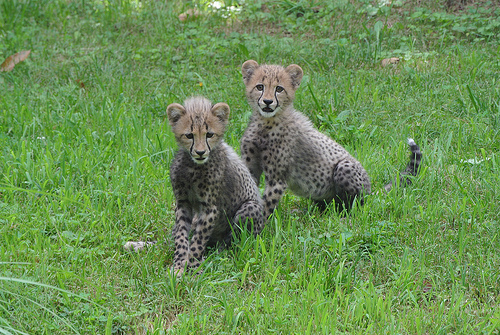Cheetah Cubs Explore Their Yard at the Smithsonian's National Zoo
Cubs to Be Named for the Fastest American Olympians as Part of National Zoo Games
The two 3-month-old cheetah cubs at the Smithsonian's National Zoo and the Olympic athletes have one thing in common: starting this week they will be showing off their speed, agility and raw, physical prowess. Just days before the opening of the Olympic Games, the Zoo is introducing the cubs to their yard at the Zoo's Cheetah Conservation Station, giving them outdoor space to romp, run and play. And soon they will have even more in common with the Olympians: In partnership with USA Track & Field, the Zoo will be naming the cubs—a male and a female—after the fastest American male and fastest American female athletes in the Olympics 100-meter dash. The possible names for the female cub: Carmelita, Tianna and Allyson; for the male cub: Justin, Tyson and Ryan.
The decision to name the cubs after the fastest Americans is part of a broader National Zoo Games campaign to celebrate the Zoo's finest animaletes. Beginning July 24 and lasting for the duration of the Olympic Games, the Zoo will be posting photos, videos and fun facts showcasing the best of sport in the animal kingdom, from weightlifting ants to water polo-playing lions. Followers can track the updates on the Zoo's Facebook page and website and through the hashtag #ZooGames on Twitter. Each activity that the animals participate in is an important component of the Zoo's Animal Enrichment program, which provides physically and mentally stimulating activities and environments for the Zoo's residents.
The cubs were born April 23 at the Smithsonian Conservation Biology Institute in Front Royal, Va. Five-year-old first-time mom Ally abandoned the male cub, which is relatively common for first-time mothers under human care, and remained in labor. When she stopped having contractions hours later, SCBI head veterinarian Dr. Copper Aitken-Palmer anesthetized her and performed a cesarean section, a procedure rarely used on cheetahs and one that cubs do not often survive. A team of veterinarians, keepers and scientists worked for three hours to resuscitate the three cubs that were delivered. The female cub survived. Since their birth, the two cubs have been hand-reared and were moved to the Zoo May 18.
The cubs will be on exhibit starting Saturday, July 28, and will have access to their yard every day at 10 a.m. and 1 p.m., for no longer than an hour at a time at first. Whether they come out and for how much of the hour they stay out will be up to the cubs.
The Smithsonian Conservation Biology Institute plays a key role in the Smithsonian's global efforts to understand and conserve species and train future generations of conservationists. Headquartered in Front Royal, Va., SCBI facilitates and promotes research programs based at Front Royal, the National Zoo in Washington, D.C., and at field research stations and training sites worldwide.

